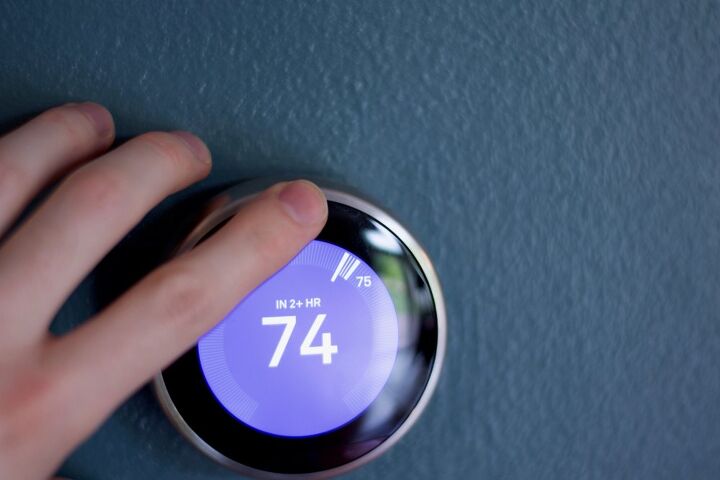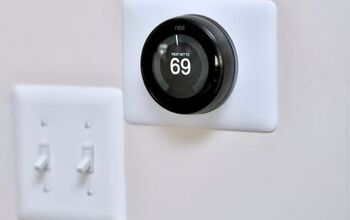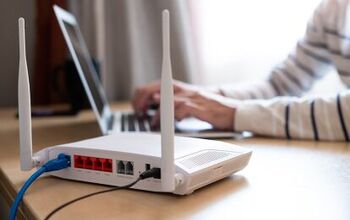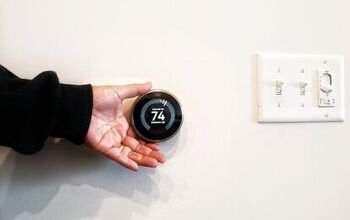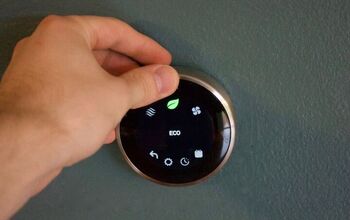Nest Thinks It's Warmer Than It Is? (Possible Causes & Fixes)

Have you ever felt that the room temperature was cooler than what your thermostat showed? Nest users have reported issues with their thermostat thinking it’s warmer than it is. A difference of a degree or two is perfectly normal. Anything more than that, though, and there may be a problem.
Nest might think it’s warmer than it is if there’s an interference, such as a vent near the thermostat. This gives Nest a false sense of the room temperature. If the Wi-Fi chip on your Nest overheats, your thermostat will read a higher temperature than what you’re feeling. It’s also possible that Nest is still learning your routine.
Do You Need Your Thermostat Repaired or Reprogrammed?
Get free, zero-commitment quotes from pro contractors near you.

Learning Technology
Nest is famous for its learning technology. As you begin to use it, it’s sensitive to the changes you make, soaking up the information until, after a week or so, it settles on a schedule.
This takes time. So, it makes sense that, when you first install your Nest, there’s an adjustment period. The temperature displayed may not be what you’re feeling. However, this difference should only be a couple of degrees.
Auto-Schedule is the setting Nest uses to learn, and it’s turned on by default. You can check this setting either on the app or on your thermostat.
In the app: On the home screen, select your thermostat. Then go to Settings > Auto-Schedule.
On your thermostat: Go to Settings > Nest Sense > Auto-Schedule.
How Nest Learns
Nest learns a different schedule for each temperature mode: Heat, Cool, and Heat·Cool. It begins learning the very first day you start using it. The exact behavior depends on whether you have one of the Nest Learning Thermostats or a Nest Thermostat E.
Day 1
Nest holds any temperature you set until it’s manually changed. So, if you set the thermostat to 68°F, it stays there until someone changes it.
Nest E has an option to choose a pre-programmed schedule at the initial set-up. The pre-programmed schedule works in conjunction with Auto-Schedule. If you have Auto-Schedule on in addition to the pre-programmed schedule, Nest will learn your routine on top of the pre-programming.
Nest E holds the set temperature until someone changes it or until the next scheduled temperature change—whichever comes first.
Day 2-3
Nest continues learning your personal schedule. Each time you make adjustments, Nest takes note and corrects it for the following day. It also attempts to decipher when you’re home and away by how often you walk by your thermostat or adjust the temperature.
After a Week
After about a week, Nest settles into a schedule and is less sensitive to adjustments you make. While it continues to learn, the learning is confined to a pattern of at least two similar changes.
For example, if you make adjustments to the temperature on two weekdays in a row, Nest changes the schedule for every weekday. Let’s say you make a change two Mondays in a row. Nest adjusts the schedule every Monday moving forward.
In the first week with your Nest, temperature discrepancies are totally normal—but only by a few degrees.
Abnormal Temperature Discrepancies
Outside of the learning period, Nest can read temperatures inaccurately, indicating a problem with the device. Nest may give an inaccurate temperature reading for the following reasons:
- It’s located in a warm or cool spot.
- It can’t decipher the true room temperature due to interference.
- The Wi-Fi chip has overheated.
- You have a Nest Temperature Sensor installed.
- You have Farsight enabled.
Location, Location, Location
The location of your Nest plays a big part in the accuracy of its temperature readings. Because of its motion sensors, Nest needs to be placed in a highly trafficked area. The motion sensors pick up on activity and let Nest know to follow the proper heating and cooling schedule.
Most homes heat and cool unevenly. (I find this particularly true in my split-level home.) In a two-story home, the average temperature difference between the upstairs and downstairs can be between 8 and 10 degrees.
If your Nest happens to be placed in a particularly warm area of your home, the temperature probably reads higher than if you’re downstairs.
The Fix: Change the location of your thermostat to a more even-temperature area. Or purchase a Nest Temperature Sensor for more accurate readings.
Interference
Most Nest users install their thermostats on the wall (though the 3rd Generation comes with a stand option). In this scenario, it’s possible Nest is giving an inaccurate reading because of a hole or vent causing an air leak. Or it may even be due to poorly insulated walls.
Nest will give an inaccurate temperature reading if it can’t decipher the actual room temperature due to interference. A vent blowing hot air directly onto the thermostat will make Nest think it’s warmer than it is.
The Fix: You can try patching any holes that are causing air leaks or installing better insulation in the Nest-mounted wall. Otherwise, physically moving the Nest is your best option.
Overheated Wi-Fi Chip
There is a known issue where a small percentage of users report a malfunction with their Wi-Fi chip. If the Wi-Fi chip overheats, Nest produces temperature readings that are higher than they actually are. Google gives a very ambiguous reason as to why the chip overheats, blaming certain wireless access points.
The Fix: Disconnect Nest from your network for 12-24 hours and monitor the temperature on your thermostat. If the temperature is still reading high, the Wi-Fi chip is not the problem. If after disconnecting from the network, you notice a drop in the temperature reading, the Wi-Fi chip was the cause.
As long as your Nest is still under warranty, the Wi-Fi chip issue is reason enough for a replacement. Otherwise, Nest maintains there’s nothing they can do and suggests purchasing a new device.
Nest Temperature Sensor
Because of the problem of uneven air distribution, a Nest Temperature Sensor may give a different reading than the thermostat. The sensor could be in an area that’s much hotter or colder than both your location and the thermostat’s location. This could be a reason for a higher temperature reading from Nest.
If the temperature difference is too great, you should receive an error message asking you to move the sensor.
The Fix: Relocate either the sensor or the thermostat.
Farsight
This is a feature on the 3rd Generation that shows helpful information when you approach the thermostat. One option is for Farsight to display either the target temperature or the current room temperature.
If Nest says it’s warmer than it is, you may have Farsight set to show the target temperature. By default, Farsight is turned on and set to show you the target temperature.
The Fix: To change the Farsight settings, press the ring on your thermostat. This opens the Quick View screen. Using the ring to navigate, turn it to Settings and press down to select. Choose Display > Farsight. From here, you can choose to display the current temperature or simply shut off Farsight by selecting None.
Factory Reset
One last way to fix an incorrect temperature reading on your Nest is to perform a factory reset. This restores Nest to its factory settings, wiping away any programs and setting you had stored. Nest will have to relearn your routine.
Before resetting, Google suggests writing down your device’s wiring information in the event you need to input it while reprogramming. This information can be found on your thermostat by going to Settings > Equipment.
To reset a Nest Thermostat, go to Settings > Factory Reset. When prompted, confirm your choice, and wait a few moments for the reset to take effect.
To reset a Nest Learning Thermostat or a Nest E, go to Settings > Reset. From the list provided, choose All Settings. This restores Nest to its factory setting. You also have to remove your account from the Nest app beforehand.
Call Customer Support
If none of the above seems like your issue or your problem still isn’t solved, it’s time to call Nest’s Customer Support. They may know of other troubleshooting methods to help fix inaccurate temperature readings.
Related Questions
Why does my Nest take so long to cool?
As a safety feature, most HVAC systems have a built-in delay before kicking on. In addition to the HVAC delay, Nest also employs a start-up delay. This is so things like the compressor don’t get overworked and wear down too quickly. Both delays can have an effect on how long it takes to heat or cool your home.
How do I set my Nest thermostat to hold temperature?
On your thermostat, go to Main Menu > Hold. Choose between Current temp or Eco. Pick the end time for the hold. Select Confirm.
Do You Need Your Thermostat Repaired or Reprogrammed?
Get free, zero-commitment quotes from pro contractors near you.

Summing It Up
It’s normal for your Nest to display a temperature that varies by a few degrees, especially while it’s still learning. If you notice anything more, you may need to adjust the location of your Nest due to uneven airflow or interference. You can also check for an overheated Wi-Fi chip or adjust how Nest displays temperatures through the Farsight setting.

Brigid Levi is a wife, mother, and freelance writer who enjoys a good DIY project and creating beautiful spaces within her home. From cleaning and organization hacks to home decor ideas, she loves helping people in their quest to turn a house into a home. Her hobbies include pretending to be Joanna Gaines while updating her home with her husband and performing in local theater productions.
More by Brigid Levi



